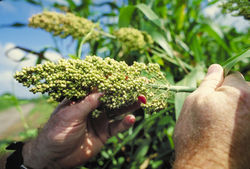Sorghum
2008/9 Schools Wikipedia Selection. Related subjects: Plants
| Sorghum | ||||||||||||
|---|---|---|---|---|---|---|---|---|---|---|---|---|
 |
||||||||||||
| Scientific classification | ||||||||||||
|
||||||||||||
| Species | ||||||||||||
|
About 30 species, see text |
Sorghum is a genus of numerous species of grasses, some of which are raised for grain and many of which are used as fodder plants either cultivated or as part of pasture. The plants are cultivated in warmer climates worldwide. Species are native to tropical and subtropical regions of all continents in addition to Oceania and Australasia. Sorghum is in the subfamily Panicoideae and the tribe Andropogoneae (the tribe of big bluestem and sugar cane). Sorghum is known as great millet and guinea corn in West Africa, kafir corn in South Africa, dura in Sudan, mtama in eastern Africa, jowar in Hindi, solam in Tamil and kaoliang in China.
History
Most cultivated varieties of sorghum can be traced back to Africa, where they grow on savanna lands. In ancient times sorghum was also grown in India. During the Muslim Agricultural Revolution, sorghum was planted extensively in parts of the Middle East, North Africa and Europe. The name "sorghum" comes from Italian "sorgo", in turn from Latin "Syricum (granum)" meaning "grain of Syria".
Tenth century records indicate that it was widely grown in Iraq, and became the principal food of Kirman in Persia. In addition to the eastern parts of the Muslim world, the crop was also grown in Egypt and later in Islamic Spain. From Islamic Spain it was introduced to Christian Spain and then France (by the twelfth century). In the Muslim world, sorghum was grown usually in areas where the soil was poor or the weather too hot and dry to grow other crops.
Cultivation and uses
Numerous Sorghum species are used for food (as grain and in sorghum syrup or "sorghum molasses"), fodder, the production of alcoholic beverages, as well as biofuels. Most species are drought tolerant and heat tolerant and are especially important in arid regions. They form an important component of pastures in many tropical regions. Sorghum species are an important food crop in Africa, Central America, and South Asia and is the "fifth most important cereal crop grown in the world".
In Arab cuisine, the unmilled grain is often cooked to make cous-cous, porridges, soups, and cakes. Many poor use it, along with other flours or starches, to make bread. The seeds and stalks are fed to cattle and poultry. Some varieties have been used for thatch, fencing, baskets, brushes and brooms, and stalks have been used as fuel. Medieval Islamic texts list medical uses for the plant.
A sorghum species, Johnson Grass, is classified as a noxious weed.
The reclaimed stalks of the sorghum plant are used to make a decorative millwork material marketed as Kirei board.
Some species of sorghum can contain levels of hydrogen cyanide, hordenine and nitrates lethal to grazing animals in the early stages of the plant's growth. Stressed plants, even at later stages of growth, can also contain toxic levels of cyanide.
In India, and other places, Sweet Sorghum stalks are used for producing bio-fuel by squeezing the juice and then fermenting into ethanol. Texas A&M University in the United States is currently running trials to produce the best varieties for ethanol production from sorghum leaves and stalks in the USA.
